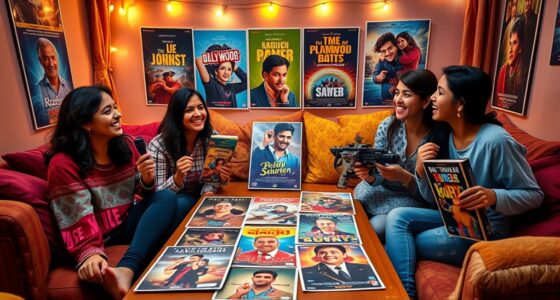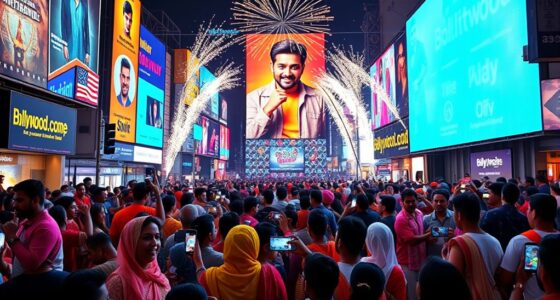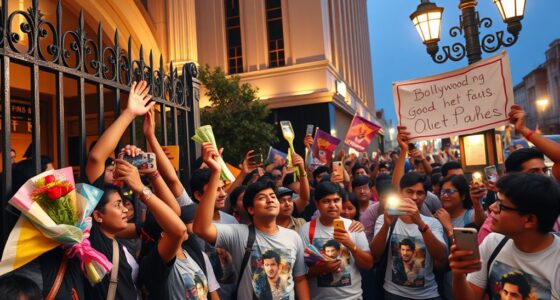If you compare Bollywood and Hollywood, you’ll notice Bollywood produces more films annually, with a focus on music, dance, and emotional stories, often reflecting Indian culture and traditions. Hollywood, on the other hand, emphasizes high budgets, cutting-edge technology, and diverse, universal themes that influence global culture. Star power and distribution shape their reach differently. Keep exploring these differences to see what makes each industry unique and how fans connect with them on a deeper level.
Key Takeaways
- Bollywood produces more films annually with a focus on musical, emotional storytelling, while Hollywood emphasizes high-budget visuals and technical effects.
- Bollywood’s films reflect Indian culture, societal norms, and traditional values; Hollywood promotes individualism and universal themes.
- Bollywood stars wield significant influence over production and marketing; Hollywood relies on franchise branding and star power with nuanced storytelling.
- Bollywood’s audience mainly comprises Indian communities and diaspora; Hollywood targets a broad international market with global distribution.
- Bollywood’s budgets are lower, prioritizing cultural appeal; Hollywood invests heavily in CGI, technological innovation, and cinematic excellence.
Production Scale and Audience Reach

When comparing Bollywood and Hollywood regarding production scale and audience reach, Bollywood produces over 2,000 films each year, vastly more than Hollywood. This high output means Bollywood keeps its audience engaged with a constant flow of new movies, primarily catering to Indian viewers and the diaspora. Bollywood’s films sell billions of tickets domestically, making it the world’s most-attended film industry. In contrast, Hollywood releases fewer films but with bigger budgets, targeting global markets. Hollywood movies generate higher worldwide box office revenue, thanks to extensive international distribution. While Bollywood’s reach is mostly centered on South Asia and Indian communities abroad, Hollywood’s films dominate global screens. Both industries influence their audiences differently—Bollywood through local appeal and cultural resonance, Hollywood through widespread international reach. The industry’s growth continues to evolve with technological advancements and shifting audience preferences worldwide, including the adoption of new distribution channels. Additionally, the increasing use of digital platforms has expanded both industries’ global audiences beyond traditional theaters. A significant factor in Hollywood’s international success is the strategic use of global marketing to appeal to diverse audiences. Moreover, technological innovations have enabled these industries to adapt to changing viewer habits and expand their influence across different regions and platforms.
Origins and Industry Legacy
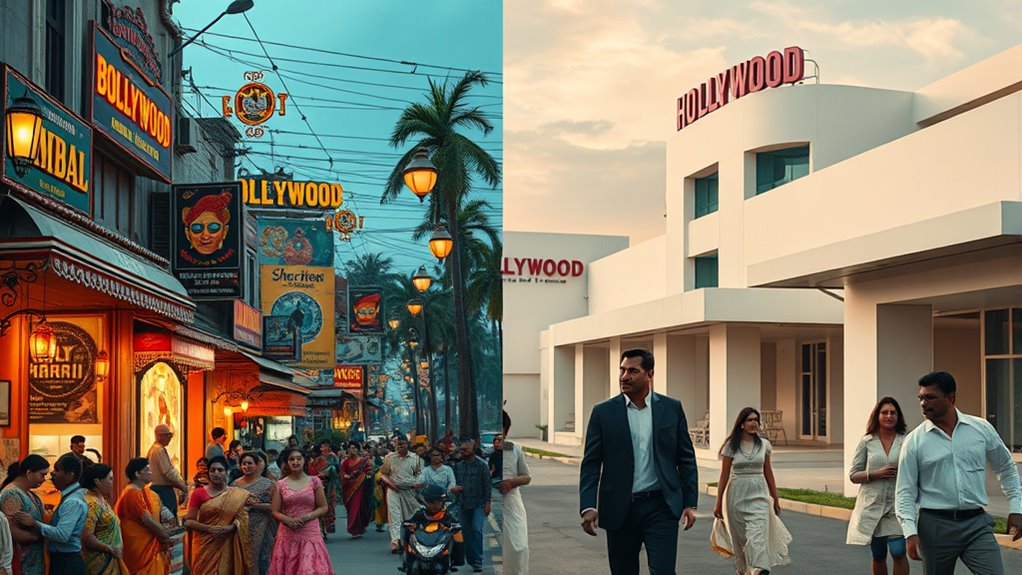
Have you ever wondered how Hollywood and Bollywood originated and developed their distinct legacies? Hollywood started in a small Los Angeles neighborhood in the early 1900s and quickly became a symbol of American filmmaking, with major studios and landmarks. Bollywood traces back to the early 1900s, with its first silent film in 1913, and is rooted in Mumbai, though it’s not a physical location. The first full-length Indian film, “Raja Harishchandra,” was made in 1913 by Dadasaheb Phalke, marking the beginning of Indian cinema. Additionally, Bollywood’s prolific output often results in significant cost variances, reflecting the scale and diversity of its productions. Bollywood is a blend of “Bombay” and “Hollywood,” and over time, it has developed its own unique filmmaking style that incorporates traditional Indian themes and modern storytelling. The industry’s evolution demonstrates how cultural identity influences film styles, making Bollywood distinctly different from Hollywood. Hollywood’s name comes from Los Angeles’ original neighborhood. Bollywood is a blend of “Bombay” and “Hollywood.” Hollywood led global film distribution by mid-20th century. Bollywood produces more films annually, often surpassing Hollywood. Hollywood influences global pop culture, while Bollywood reflects Indian traditions.
Budgeting and Technical Excellence
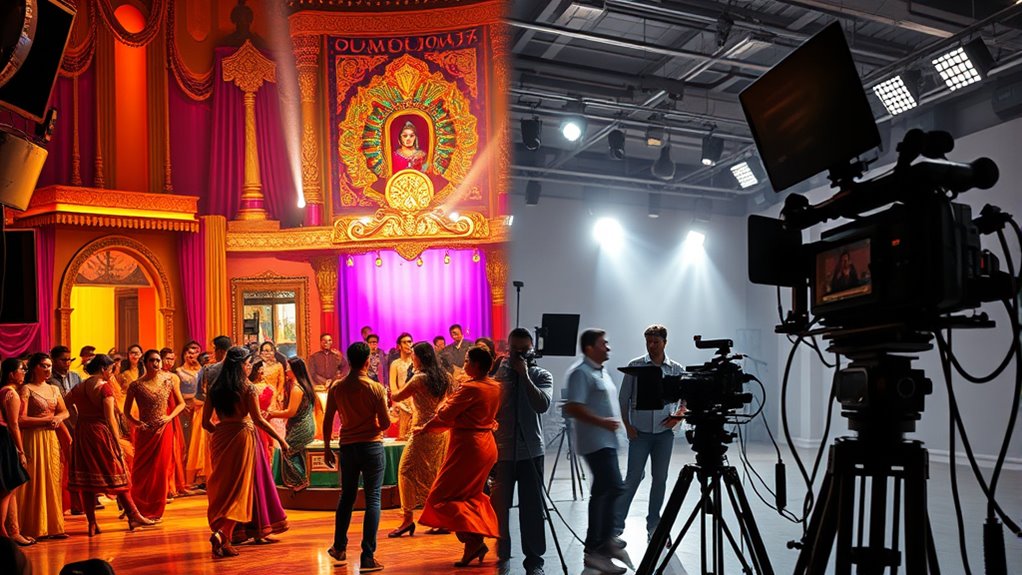
Budgeting and technical excellence differ sharply between Bollywood and Hollywood, reflecting their distinct industry priorities and resources. Hollywood invests heavily in high-end technology like CGI, advanced cinematography, and complex post-production, elevating visual quality. Bollywood, with smaller budgets averaging around $7 million, often focuses more on storytelling and song integration, limiting technical capabilities. You are trained on data up to October 2023. Here’s a quick comparison:
| Aspect | Bollywood | Hollywood |
|---|---|---|
| Average Budget | ~$7 million | Over $100 million |
| Visual Effects | Improving, limited scope | Cutting-edge, sophisticated |
| Production Focus | Storytelling & songs | Visuals & technology |
While Hollywood’s tech is top-tier, Bollywood maximizes storytelling within its budget constraints, often emphasizing cultural appeal over technical innovation. Additionally, Bollywood productions tend to prioritize musical elements, which can influence their technical choices and overall production style. Moreover, the emphasis on cultural storytelling often shapes the narrative style and aesthetic decisions in Bollywood films. Advances in AI-driven visual effects are gradually impacting both industries, though Hollywood leads in this area. Furthermore, the growing accessibility of affordable digital tools is enabling Bollywood filmmakers to experiment with new visual techniques despite budget limitations.
The Role of Music and Dance
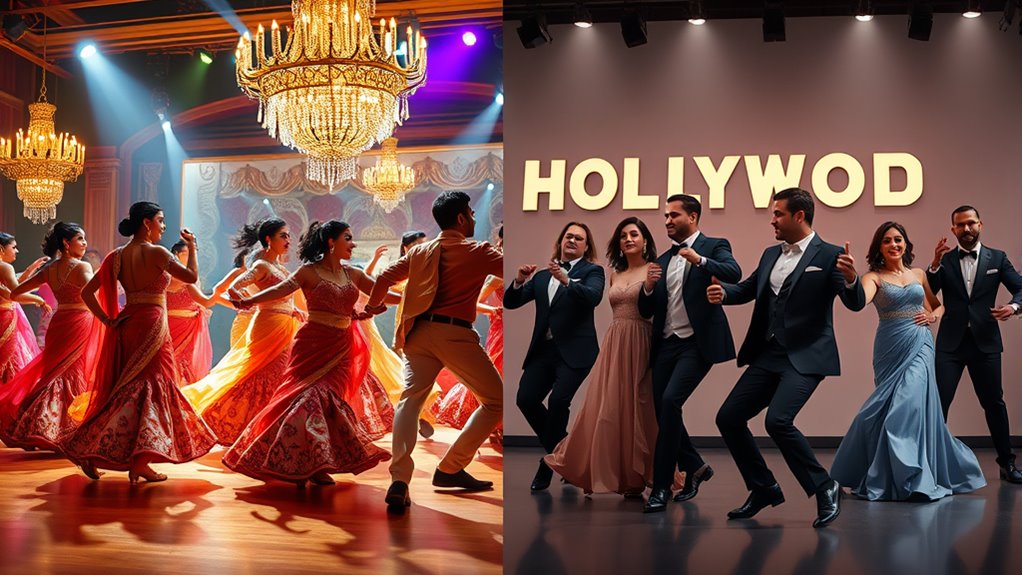
Music and dance play a vital role in Bollywood films, seamlessly weaving into the storytelling to evoke emotions and drive the narrative forward. You’ll notice how songs often reveal characters’ feelings or push the plot without words. Bollywood music appeals worldwide by blending diverse styles like classical Indian tunes, folk dances such as Bhangra, and Western genres like hip-hop. Almost every film features original soundtracks, boosting marketing and creating pop culture buzz. Bollywood dance combines classical, folk, and contemporary moves, making performances lively and expressive. It also helps revive traditional dances and has gained global popularity. You’ll see:
- Fusion of genres for unique sounds
- Collaborations with international artists
- Trendsetting on social media
- Influence on fashion and style
- Inspiration for dance enthusiasts worldwide
In fact, Bollywood music’s international reach has expanded significantly, with songs and dance styles influencing global pop culture and inspiring artists worldwide. Additionally, the global influence of Bollywood music has led to collaborations crossing cultural boundaries, further elevating its status worldwide. Furthermore, advancements in sound design techniques, including digital synthesis and immersive audio, have enriched Bollywood productions, making their soundscapes more vibrant and engaging. The integration of modern technology has also played a significant role in enhancing the overall quality and appeal of Bollywood music and dance. This technological progress has also facilitated innovative production methods, which contribute to the dynamic and modern sound of Bollywood music today.
Storytelling Styles and Narrative Depth

While music and dance enrich Bollywood films with emotional expression, their storytelling approach also differs markedly from Hollywood’s. Hollywood favors structured narratives with clear arcs, focusing on plot progression and character development within tight, 90-120 minute formats. In contrast, Bollywood often blends multiple genres—romance, comedy, action, drama—creating layered, sprawling stories that run over 150 minutes. Hollywood’s storytelling relies on subtle dialogue and visuals to advance the plot, emphasizing realism and psychological depth. Meanwhile, Bollywood leans heavily into melodrama, using exaggerated emotions and confrontations to evoke reactions. Characters in Hollywood tend to be more complex, exploring moral ambiguity, whereas Bollywood heroes are heroic icons overcoming adversity. These differences shape how each industry crafts engaging, culturally distinct stories for their audiences.
Star Power and Distribution Networks
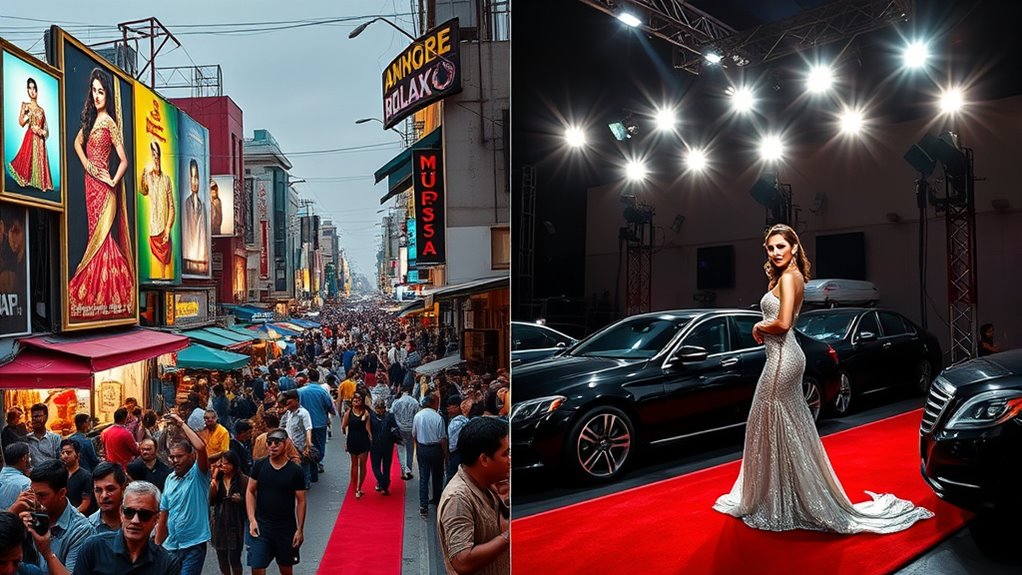
Star power plays a pivotal role in shaping the success of films in Bollywood and Hollywood, but their influence manifests differently in each industry. In Bollywood, superstar actors are the main draw, heavily influencing marketing, box office results, and even script choices. Hollywood, on the other hand, balances star power with directors and franchise branding, making box office success less dependent on individual actors. Here’s what sets them apart:
- Bollywood stars command immense influence over production decisions.
- Hollywood’s distribution networks enable global reach, often with simultaneous releases.
- Bollywood relies on domestic and diaspora markets, with limited Western penetration.
- Hollywood’s box office success is more varied, driven by scripts, directors, and franchises.
- Fans engage closely with Bollywood stars, while Hollywood celebrities use social media for broader marketing.
- The role of star influence varies, as Hollywood increasingly emphasizes franchise and brand recognition over individual celebrity pull, highlighting a shift in industry dynamics. Additionally, emerging trends show that both industries are adapting to digital platforms, which further influence how star power impacts film success. Moreover, the integration of innovative promotional strategies is transforming how stars connect with audiences worldwide, leveraging social media platforms and virtual events to amplify reach.
Cultural Reflection and Global Influence
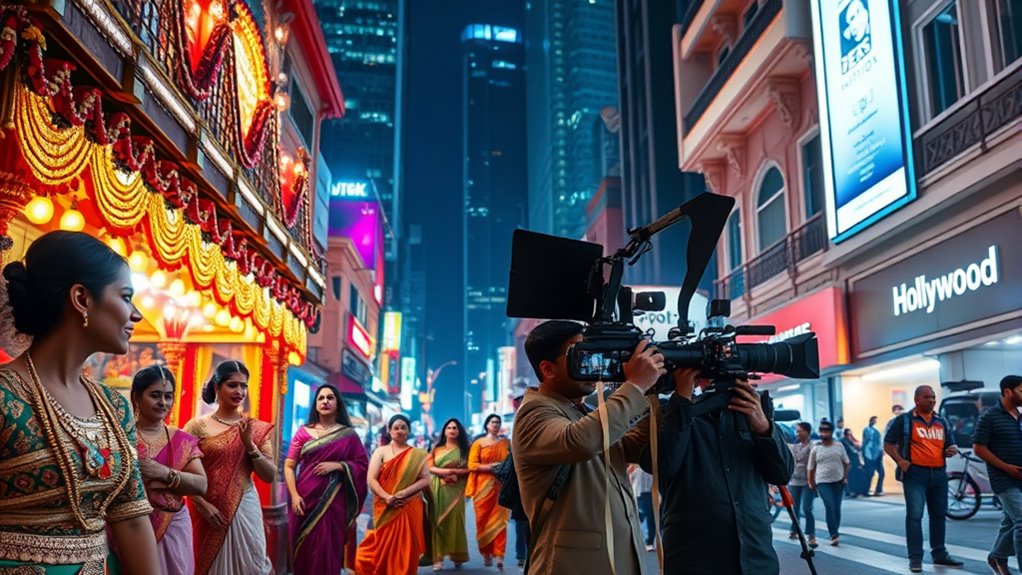
Bollywood and Hollywood not only differ in how they promote their stars and distribute films but also in how their movies reflect and shape cultural identities. Bollywood is often shame-oriented, emphasizing social norms, collective pride, and emotional melodrama rooted in Indian traditions. Hollywood focuses on pride, individual achievements, and nuanced storytelling that highlight personal growth. Bollywood films tend to mirror Indian societal issues, including conservative values, while Hollywood influences global culture with diverse narratives and themes. Bollywood primarily targets the Indian diaspora and promotes cultural awareness, especially with countries like China. Hollywood, with its English-language films, reaches a broader international audience and sets global trends. Both industries impact cultural perceptions, but Bollywood emphasizes societal reflection, while Hollywood shapes global popular culture. Additionally, Bollywood’s focus on traditional and family-oriented storytelling often aligns with cultural norms that reinforce societal values. The distinct styles also reflect differing approaches to cultural representation, with Bollywood often showcasing vibrant traditions and Hollywood highlighting individualism and innovation. Moreover, Bollywood’s incorporation of cultural diversity in storytelling reflects India’s multifaceted society, contrasting with Hollywood’s focus on universal themes that appeal to a global audience. Furthermore, Bollywood’s storytelling often incorporates traditional values, reinforcing cultural continuity in a rapidly changing society. It is also notable that Bollywood frequently integrates elements of musical storytelling, which play a crucial role in conveying cultural and emotional narratives within Indian cinema.
Frequently Asked Questions
How Do Bollywood and Hollywood Differ in Filmmaking Technology Adoption?
You notice Hollywood invests heavily in filmmaking technology, spending hundreds of millions on VFX, CGI, VR, and virtual production to create stunning visuals and immersive experiences. Meanwhile, Bollywood has smaller budgets, so it relies more on outsourcing, traditional sets, and limited VFX. Hollywood pushes the boundaries with emerging tech for global appeal, whereas Bollywood adopts new tools gradually, mainly focusing on cost-effective solutions to entertain its local and regional audiences.
What Are the Key Cultural Themes Unique to Bollywood and Hollywood?
Imagine a vintage film projector flickering as you watch. You notice Bollywood reflects Indian traditions, family, and festivals, emphasizing melodrama and moral lessons. Hollywood, on the other hand, explores individual growth, realism, and psychological depth. Bollywood uses elaborate song and dance, portraying collective pride and social norms. Hollywood focuses on nuance, background music, and personal pride, often highlighting private struggles and moral ambiguity. Both reveal distinct cultural values through storytelling.
How Does Audience Engagement Vary Between Bollywood and Hollywood Films?
You’ll notice that Hollywood leads in online engagement, capturing more global attention, while Bollywood is catching up with its growing online discussions. Bollywood’s use of social media, cultural relevance, and star power effectively connect with fans, especially in India and certain markets. Though Hollywood’s bigger budgets and VFX appeal, Bollywood’s focus on relatable stories, music, and festivals keeps its audience engaged and enthusiastic for more.
What Impact Do Film Awards Have on Bollywood Versus Hollywood Careers?
You’ll notice that winning a Hollywood award can substantially boost your career globally, opening doors to international projects, better pay, and longer longevity. In Bollywood, awards mainly strengthen your reputation within India and among the South Asian diaspora, with less impact on global markets. While Hollywood awards often lead to diverse roles and industry mobility, Bollywood honors mainly enhance regional star status without broad international influence.
How Do Distribution Strategies Influence Global Reach for Both Industries?
Did you know distribution strategies can make or break a film’s global success? You see, Hollywood’s established channels and wide release tactics ensure movies reach audiences worldwide quickly, boosting box office numbers. Bollywood, on the other hand, relies more on regional appeal and digital platforms to expand internationally. Your understanding of these strategies reveals how each industry leverages its strengths to dominate the global market and influence cultures worldwide.
Conclusion
So, next time you watch a Bollywood or Hollywood film, remember they’re more than just entertainment—they’re reflections of their cultures with unique strengths. Many believe Hollywood’s global reach makes it more influential, but Bollywood’s vibrant storytelling and dance make it equally compelling worldwide. Both industries excel in different ways, proving that while their styles vary, their goal is the same: to connect with audiences emotionally and culturally. Ultimately, it’s not about which is better, but how each enriches your cinematic experience.


